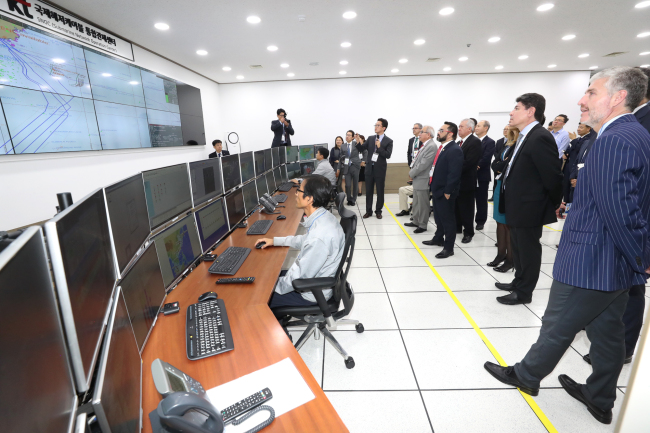[ITU 2017] KT’s control tower for undersea cables boasts cutting-edge technologies
By Kim Young-wonPublished : Sept. 26, 2017 - 15:37
BUSAN -- South Korean telecommunications firm KT has launched a control tower in Busan that manages internet cables laid thousands of feet underwater, which are often called submarine communication cables.
KT is one of multiple global network operators in charge of managing underwater cables that connect seven nations, including the US, China and Japan.
Of the entire 130-kilometer submarine cables currently up and running around the globe, the KT-backed cables account for 12 percent, or equivalent to 179 terabits per second.
KT is one of multiple global network operators in charge of managing underwater cables that connect seven nations, including the US, China and Japan.
Of the entire 130-kilometer submarine cables currently up and running around the globe, the KT-backed cables account for 12 percent, or equivalent to 179 terabits per second.

The network cables managed by the Korean network firm, the only Korean IP exchange provider that handles traffic coming in and out of Korea, processes 80 percent of the international data traffic in Korea.
The newly launched KT Submarine Cable Complex, located in Songjeong-dong, a beach area of the city, will serve as a hub responsible for installing and monitoring underwater cables, according to KT.
The control tower houses the submarine network operation center, which monitors the firm’s undersea cable infrastructure and the global telecommunication service center, in charge of operating a range of services such as international calls, mobile roaming, internet and broadcasting.
The Korean telecom company said the transmission of high-quality and voluminous content such as HD videos, will be done in a simplified manner, as the control tower equipped with advanced data processing capability can send data directly to a designated point. As a result, the network latency -- the time it takes for a packet of data to get from one point to another -- has been shortened to 1 millisecond, an improvement of 14 times from the existing traffic management system, according to the Korean firm.
To prevent the cables from being accidently damaged by fishing boats and freight vessels, KT regularly deploys a fleet of four surveillance ships fitted with cameras and radar systems to the seas off Busan, Geoje and Jeju Island.
Real-time videos from the ships are sent over Long Term Evolution networks to KT’s cable complex and analyzed to see if the submarine cables are intact while GPS-installed buoys show the exact location of the network cables.
“The center boasts nearly the shortest network latency among the world’s 25 IP exchange providers,” said Choi Hwan-gyu, the chief of KT’s network operation unit, adding the complex will be able to attract global firms to build data centers in Busan as well as other regions in Korea.
On Monday, a group of Central and South American information and communication technology ministers and high-ranking government officials, who are participating in the ongoing ITU Telecom World, an UN-backed ICT conference, visited the network complex.
“Costa Rica has its own undersea cable facilities, but those of KT seem to be more advanced and larger in size,” said Edwin Estrada Hernandez, the ICT minister of the South American nation, adding he hopes that the two nations will cooperate in the network segment down the road.
Oh Sung-mok, the chief of KT’s network business division, said the undersea cable complex boasting up-to-date network technologies will be able to take the nation’s ICT capabilities to the next level.
By Kim Young-won (wone0102@heraldcorp.com)



![[AtoZ into Korean mind] Humor in Korea: Navigating the line between what's funny and not](http://res.heraldm.com/phpwas/restmb_idxmake.php?idx=644&simg=/content/image/2024/04/22/20240422050642_0.jpg&u=)

![[Exclusive] Korean military set to ban iPhones over 'security' concerns](http://res.heraldm.com/phpwas/restmb_idxmake.php?idx=644&simg=/content/image/2024/04/23/20240423050599_0.jpg&u=20240423183955)

![[Herald Interview] Why Toss invited hackers to penetrate its system](http://res.heraldm.com/phpwas/restmb_idxmake.php?idx=644&simg=/content/image/2024/04/22/20240422050569_0.jpg&u=20240422150649)
![[Graphic News] 77% of young Koreans still financially dependent](http://res.heraldm.com/phpwas/restmb_idxmake.php?idx=644&simg=/content/image/2024/04/22/20240422050762_0.gif&u=)






![[Exclusive] Korean military to ban iPhones over security issues](http://res.heraldm.com/phpwas/restmb_idxmake.php?idx=652&simg=/content/image/2024/04/23/20240423050599_0.jpg&u=20240423183955)



![[Today’s K-pop] Ateez confirms US tour details](http://res.heraldm.com/phpwas/restmb_idxmake.php?idx=642&simg=/content/image/2024/04/23/20240423050700_0.jpg&u=)